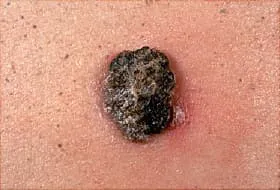Nodular melanoma is a type of skin cancer. It’s a dangerous form of melanoma that grows quickly.
Only about 15% of all melanomas are nodular. But it causes nearly half of melanoma-related deaths. So you need to know the signs. If it’s found early on, doctors may be able to cure it.
What It looks like: A nodular melanoma can look like a mole, bug bite, or pimple. Often, it looks like a round black bump. But it can be other colors.

- Legs
- Torso (chest, back, belly)
- Arms
- Head
What to do: Don’t try to pop it. The skin may break open, but there’s no pus inside. You’ll just cause a wound. If you have a new growth or spot on your skin that doesn’t go away in 5 days, see your doctor.
Symptoms
You might not notice a nodular melanoma since these cancers don’t follow the usual warning signs of melanomas.
You’ve probably heard that you should look out for moles that have:
- Asymmetry (in other words, they’re lopsided)
- Uneven borders
- Different colors
- Spread or become large
But nodular melanomas are different. They don’t fit those guidelines. They usually appear as a round black bump. They can also be blue, gray, red, or white. And it’s rare, but about 5% of the time, they don’t have an unusual color. They can be pink, tan, or flesh-toned. The melanoma is often solid in color with even borders.
Causes
One main cause is the UV light from the daylight and tanning beds. Their rays can harm the skin’s DNA. This damage can happen over many years or even decades. But not all nodular melanomas are directly caused by UV rays. Although it’s less common, they can also develop on parts of your body that aren’t exposed to the sun.
When the DNA in skin cells becomes damaged, new cells can grow out of control. This can lead to melanoma. Experts aren’t exactly sure what causes this DNA damage and how it brings on cancer. It’s probably due to a mix of your genes, lifestyle habits, and UV exposure.
Melanomas develop in the cells that give your skin its color. Most of the time, they spread slowly in your skin’s top layer. But in nodular melanoma, the cancer grows downward. It can get into tissues, bones, and lymph nodes within weeks or months. That’s when the cancer is harder to treat.
Who Gets It?
Anyone can develop nodular melanoma. But it’s more common in men than women. The disease is most often found in men ages 50 and older.
You’re more likely to get the cancer if you have one or more of the following:
- A family member who has or had skin cancer
- Pale skin that burns easily
- More than a few unusual-looking moles
- A history of spending lots of time in the sun
Diagnosis
A dermatologist will check your skin. If a spot or bump looks suspicious, you’ll get a biopsy. That’s when the doctor removes some or all of the growth and sends the tissue to a lab for testing.
A doctor called a pathologist will look at the tissue and cells under a microscope to check if it’s nodular melanoma. The pathologist can also measure the melanoma’s thickness, which helps determine the cancer’s “stage.” The thicker the melanoma, the more it has grown into the skin.
If the melanoma is more than 1 millimeter thick, you’ll probably get a biopsy of your lymph nodes. This may help doctors find out if the cancer has spread to other parts of your body.
Treatment
Your treatment will depend on how much the cancer has spread. If the nodular melanoma is caught in a very early stage, your dermatologist will recommend surgery. A surgeon will remove the melanoma, plus some of the normal skin surrounding it and a layer of tissue beneath. This may be the only treatment you need.
Most nodular melanomas are diagnosed after the cancer has already spread. You’ll need a different treatment. Options may include:
Lymph node surgery: If the cancer has spread to the lymph nodes, a surgeon may remove them.
Chemotherapy: In this treatment, drugs are injected into a vein or taken by pill. They travel through the bloodstream to kill cancer cells.
Radiation therapy: This therapy uses powerful rays, such as X-rays, to kill cancer cells. It’s sometimes used after lymph node surgery. This is done to prevent the melanoma from returning.
Immunotherapy: These medicines boost your immune system. That helps your body spot and destroy cancer cells. It’s often used for advanced melanomas.
Targeted therapy: These drugs target certain parts of melanoma cells. They may work when chemotherapy doesn’t. This treatment is only used if you have a certain genetic mutation. Your doctor will test your melanoma cells to see if targeted therapy is right for you.

